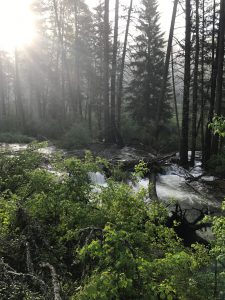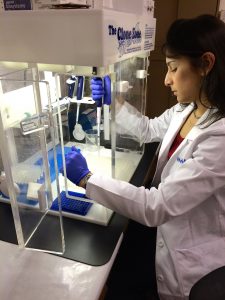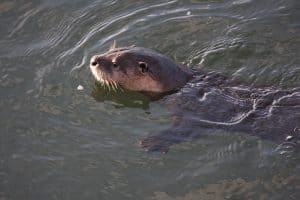Share this article
eDNA – Not just for fisheries biologists anymore – from The Wildlife Professional
Not all field sampling days are filled with summer sun and hiking through alpine meadows, but this one was, and it was just about as good as they come. The sun was up over the narrow valley, evaporating the morning dew off lupines and balsamroot, stirring an intertwined scent characteristic of late spring in the Rockies.

Rattlesnake Creek rushes through its namesake mountains near Missoula, Mont., where researchers with the National Genomics Center for Wildlife and Fish Conservation have been collecting eDNA samples from water, soil, air and other sources to monitor a range of wildlife in the ecosystem. ©Michael K. Schwartz
We headed into the Rattlesnake Mountains outside Missoula, Mont. to sample water flowing from Rattlesnake Creek. The howling of the creek, which drains the National Recreation Area (NRA) of the Lolo National Forest, was echoing off steep cliffs, occasionally punctuated by the repeated crisp tones of an American dipper nesting on the rock wall.
We set up our equipment along the river’s edge and quickly filtered five liters of water through our sampling kit. We had come to collect environmental DNA (eDNA) — DNA that is shed by an organism into the surrounding environment (Jerde et al. 2011). The collection of that eDNA from water, air, or soil is surging in popularity as a method for detecting rare or difficult to sample species without handling or observing them. It is proving to be faster, more sensitive and more cost-effective than traditional sampling methods for many taxa (Wilcox et al. 2016). Because of this, eDNA sampling allows biologists and managers to rapidly and inexpensively determine the distribution of species over broad geographic areas and with greater confidence than ever before (McKelvey et al. 2016). Over the past ten years, eDNA sampling has been rapidly adopted to detect changes in the distribution of threatened and endangered species as well as to monitor for invasive species.
The use of eDNA sampling for fish and amphibian monitoring is widely known. Fisheries biologists, in particular, have embraced the eDNA revolution. Over 150 papers in the published literature used sampled water for the detection of everything from minnows (Rhinichthys cobitis and Meda fulgida; Dysthe et al. 2017) to whale sharks (Rhincodon typus; Sigsgaard et al. 2016).
It is increasingly clear, however, that eDNA sampling also has much to offer wildlife biologists working with mammals, birds and other taxa.
Evolution of Non-Invasive Technologies
On this spectacular day in the Rattlesnake NRA, while we waited for our water to filter, we began to discuss the potential of eDNA sampling to detect a variety of animals on the national forest other than fish. New technologies, we realized, are taking us from detection of a single species to revealing all species in an entire biological community. Although our research group at the National Genomics Center for Wildlife and Fish Conservation (NGC) is best known for eDNA sampling of fish, we have also developed the eDNA sampling tools to survey for rare or recovering mammals, water birds and amphibians (Padgett-Stewart et al. 2016). Other groups have designed similar eDNA tools to survey water bodies for invasive wildlife such as feral swine (Sus scrofa) and pythons (Python molurus bivittatus; Hunter et al. 2015, Williams 2017) and many groups are chasing the holy grail of establishing a standard approach to sample all life in a stream simultaneously.
Moving from fish to wildlife
Although fisheries biologists have embraced eDNA sampling, its application in wildlife is relatively new. Yet, it has its roots in non-invasive genetic sampling, a tool commonly used by wildlife agencies to assess and monitor wildlife species (Marucco et al. 2011). Non-invasive genetic sampling is a way to detect wildlife species without having to disturb — or sometimes even influence — the behavior of the wildlife species under study. It has been used in studies of occupancy, abundance estimation, survival, dispersal and even community interactions. With eDNA sampling rather than collecting non-invasive samples like hair, feathers or scat, researchers sample only the water, soil or air with the goal of obtaining enough DNA sloughed by the target organism for detection in the lab, even if that organism is nowhere to be seen.
This characteristic of the eDNA sampling technique — basically taking a blind sample of the environment — is both the method’s greatest strength and largest challenge. It is rapid and sensitive because researchers need not capture the target species in any way such as locating scat or hair for detection. However, analysis of environmental samples is nuanced. First, there are challenges unique to field sampling, and second, there is a variety of molecular genetics tools that can be used, each with its own strengths and weaknesses that should be carefully considered to maximize compatibility with the specific research goal.
Designing field protocols

This eDNA sampling system, used by the National Genomics Center for Wildlife and Fish Conservation, allows biologists to take large samples of water and filter them in the field. ©M. K. Young
One of the first challenges for wildlife biologists is designing an effective eDNA sampling protocol. The protocols for sampling aquatic resources are generally similar: DNA is extracted from a relatively large water sample, typically 0.5 to five liters. Often the DNA is initially concentrated by filtration, which can be done in the field (Laramie et al. 2015, Carim et al. 2016), then extracted from the filter in the lab. The same protocols we use for aquatic species also work for detecting semi-aquatic terrestrial mammals, amphibians and other species that may slough cells off into the water.
At the NGC, Padgett-Stewart et al. (2016) used a fish eDNA sampling protocol (Carim et al. 2016) that filters five liters of water and newly designed molecular genetic tools to show the feasibility of detecting North American river otters (Lontra canadensis) in a captive setting. Recently, in collaboration with the Kalispel Tribe in northeastern Washington, the NGC confirmed it could also be used in the field at sites where a recovering population of river otters had recently been sighted (K. Carim and N. Bean personal communication).
This project suggests that eDNA sampling may be useful for monitoring the recovery of the species. Environmental DNA sampling also has been used to detect Burmese pythons in Florida (Piaggio et al. 2013, Hunter et al. 2015), and we are currently working toward detecting waterfowl such as the Harlequin duck (Histrionicus histrionicus). Studies have even demonstrated detection of terrestrial animals, including coyotes (Canis latrans) and feral swine, using water samples from watering holes (Rodgers and Mock 2015; Williams 2017).
The land frontier
Terrestrial animals also leave traces of DNA where they have been on land. Researchers have sampled soil for eDNA to infer the presence of ancient animal and hominid communities, an approach that may also be applicable to contemporary wildlife communities. Andersen et al. (2012) used soil samples to identify large-mammal DNA in enclosure experiments. Similarly, Dalen et al. (2007) showed the ability to detect Arctic fox (Alopex lagopus) DNA in a two-day-old footprint in the snow. Environmental DNA may also be concentrated where animals feed. Nichols et al. (2012) were able to determine ungulate species from saliva left on browsed twigs, and Ishige et al. (2017) detected endangered mammal species from eDNA left at natural saltlicks in Borneo.
Creative wildlife biology professionals have also used other eDNA-like approaches to survey for rare wildlife. One example is the emerging field of invertebrate DNA (iDNA), which samples the gut contents of common invertebrates for the detection of DNA from rare animals. Schnell et al. (2012) collected leeches (Haemadipsa spp.) in Vietnam to sample their last blood meal to detect rare mammalian species such as the Truong Son muntjac (Muntiacus truongsonensis) and Annamite striped rabbit (Nesolagus timminsi). At field sites in Côte d’Ivoire and western Madagascar, Calvignac-Spencer et al. (2013) identified all manner of artiodactylids, chiropterids, primates, rodents, birds and amphibians by sampling carrion flies.
The detailed, on-the-ground knowledge of wildlife biologists makes them well-suited to develop efficient, reliable and innovative eDNA sampling protocols. To be successful, though, biologists need robust molecular tools sensitive enough to detect DNA when it is present in the collected sample. These techniques fall into two categories: tools designed for extreme sensitivity for single species detection and approaches for simultaneous detection of multiple species, but with possibly lower detection sensitivity.
In the laboratory

Biologists K. Carim extracts eDNA from a filter to determine what organisms have sloughed DNA into the water source. ©Michael K. Schwartz
To design the appropriate molecular genetic tool for their needs, wildlife biologists should work closely with an experienced molecular genetics laboratory. Early eDNA studies used traditional polymerase chain reaction (PCR) assays, an enzymatic process commonly used to amplify DNA in genetics laboratories. However, eDNA analysis has benefitted from the adoption of the quantitative PCR (qPCR) technology, which uses fluorescent markers to track the amplification process. Many qPCR assays use a taxon-specific probe, which allows greater specificity than is possible using conventional PCR. Careful qPCR assay design facilitates unambiguous detection of even very closely related taxa (Wilcox et al. 2015). Another single species technology used in some laboratories is droplet digital PCR (ddPCR), which is even more sensitive than qPCR for detecting rare DNA. Other technologies on the horizon include Loop-mediated isothermal AMPlification (LAMP), which is an alternative to PCR that may provide greater sensitivity for detection of rare DNA and facilitate rapid, in-field analyses (Lee 2017). Wildlife biologists should keep an eye on these technologies as they become less expensive, more sensitive and more portable.
From one to many
Single-species detection approaches have dominated the eDNA world because they are easy to use in the field, have straightforward costs and have low false-positive rates once a robust assay is developed. However, the potential to detect multiple species simultaneously is alluring for biodiversity assessments and understanding community-level interactions. These multispecies approaches fall under the umbrella of genomics or metagenomics (Thomsen et al. 2012). DNA from the species of interest may be enriched in several ways including PCR — known as “metabarcoding” (Taberlet et al. 2012) — and capture, which uses DNA sequences of multiple species of interest as “fishing lines” to pull out targets of interest (Jones and Good 2013). Afterwards, the DNA can be sequenced and then those sequences assigned to taxa using a reference database.
The NGC is adapting and developing a multispecies approach using multiplexed, parallel amplification to understand aquatic biodiversity in streams, focusing on fish, amphibians, crayfish, mussels and pathogens. This method is based on an approach pioneered by NGC scientists based at the U.S. Forest Service’s Pacific Northwest Research Station. Called massively-parallel barcode sequencing, the method has been applied to screen for animals of conservation concern, tree species and even the microflora on trees. The advantage of this approach over other methods is that the enormous capacity of modern DNA sequencers — up to 400 million sequences and 80 billion bases per sample, or the equivalent of 25 human genomes — is harnessed to identify a variety of species from multiple water samples simultaneously.
Preliminary results show that 48 species can be detected and identified across 48 samples in a single assay, along with additional information on genetic diversity estimates for each target species. Ultimately, this approach can be scaled up to provide a more comprehensive understanding of aquatic biodiversity in streams. Using this approach, we have been able to detect signal crayfish (Pacifastacus leniusculus), coastal giant salamanders (Dicamptodon tenebrosus), coastal tailed frogs (Ascaphus truei), other stream-living amphibians and both plant and animal pathogens, but it would also be possible to screen for mammals and birds.
Challenges and tradeoffs

eDNA is best known for identifying fish species, but it can also detect other species, including mammals. Working with Washington’s Kalispel Tribe, biologists with the National Genomics Center for Wildlife and Fish Conservation succeeded in using a sampling protocol originally developed to identify fish to confirm the presence of river otters. ©J. Greer
Sequencing-based, multi-species approaches will ultimately be the most powerful and cost-effective way to detect many species from one water sample. These approaches face several challenges that limit their use currently though. First, few tests have compared multi-species/metagenomic and single-species methods (namely qPCR, ddPCR and LAMP assays). Second, metagenomic approaches present an inherent tradeoff. Biologists must choose between sensitivity — being able to detect rare species and rare DNA in a mixed sample — and generality, being able to detect species across broad taxonomic groups. This tradeoff may limit the effectiveness of these approaches for rare taxa. Third, metagenomic approaches require additional bioinformatics analysis that can be expensive. The output of metagenomic tests are DNA sequences that still need to be mapped to a reference database of known species. Essentially, the ability to identify each species depends on whether information is available to identify it, which may be limiting for some taxonomic groups.
Nonetheless, the promise of metagenomic approaches is enormous; they have the potential to answer pressing biodiversity questions and change how we view relationships among species in an ecosystem.
In the field
As we packed up our eDNA sampling kit on Rattlesnake Creek, we began discussing a recent eDNA metagenomics study from NGC scientists focusing on this creek. The team sampled water about a half-kilometer from a beaver dam, as well as at two other sites about three kilometers upstream and downstream. All three samples revealed a suite of species, but beaver (Castor Canadensis) sequences were only detected at the site just below the dam. The technique is promising, we realized, but challenges to implementation in the field remain.
On the hike out of the wilderness with our eDNA samples in tow, we reflect on how primed the wildlife biology field is to see an explosion of new studies involving creative uses of environmental DNA to detect rare species. Rapid advances will come in how various DNA-containing sources are sampled, whether this is water, soil, honey, twigs, air, or something else. There will also be advances in the molecular genetic technologies. This may force a trade-off between sensitivity and efficiency in detection. If the detection of an invasive species is paramount, qPCR or ddPCR may be the best option, but if some sensitivity can be forgone, the ability to assay for suites of species simultaneously may lead wildlife biologists to use multi-species genomic approaches. Ultimately, eDNA offers a rapid and accurate assessment of species and biodiversity from the water, but also from the broader landscape.
 As we reached the trailhead we recognized the excitement not only of spending the day in the field but of being at the forefront of a revolution taking place in wildlife biology.
As we reached the trailhead we recognized the excitement not only of spending the day in the field but of being at the forefront of a revolution taking place in wildlife biology.
To cite this article: Schwartz, M.K., B. E. Penaluna, and T.M. Wilcox. 2017. Not just for fisheries biologists anymore: environmental DNA sampling makes strides in wildlife. The Wildlife Professional 11.6: 47-51.
Header Image: A beaver sits on a line of ice in Rattlesnake Creek, leaving behind DNA in the water. Researchers can detect the beaver’s presence by carefully designing water sampling techniques and using taxon-specific genomic analyses in the laboratory. ©J. Greer











